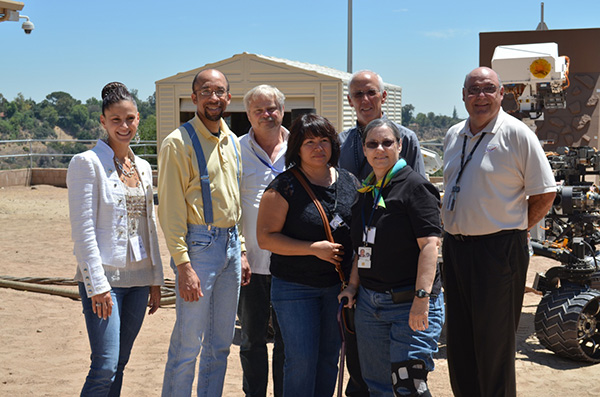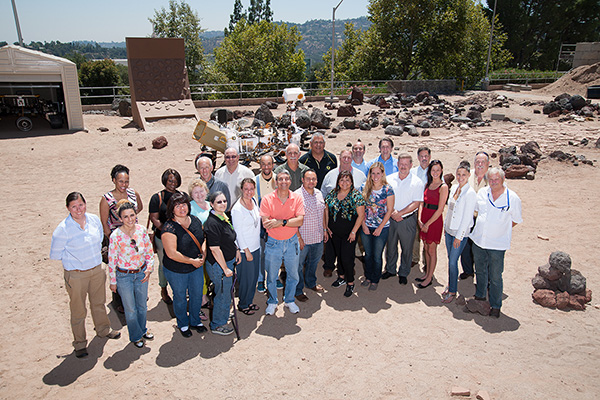Update: Please note that NASA Safety Center Knowledge Now transitioned to Kennedy Space Center's SharePoint in September 2017.
NASA’s Mishap Program Working Group (MPWG) met at the Jet Propulsion Laboratory (JPL) for its annual face-to-face operational meeting in August. The theme of this year’s meeting was, “How do we get better?”
Group chair Gerry Schumann also wanted to use this time to explore the group’s place in NASA’s ever-changing environment.
“We no longer have the space shuttle or a big program to focus on,” explained Schumann. “It’s a different world, and we need to rise up and continue to meet the intent of what we’re here to do.”
During the meeting, centers provided status updates that focused on lessons learned and best practices from the last year. Discussion highlights included the status of changes to NASA Procedural Requirement (NPR) 8621.1B, development of a mishap investigation handbook, plans for an Interim Response Team (IRT) training course and updates on safety culture.
The mishap investigation handbook, which has a planned publish date of November or December of this year, will serve as a guide for people completing safety investigations.
“The handbook will be a nice how-to collection of tools and techniques,” said Steve Lilley, senior safety engineer in the Mishap Investigation Support Office (MISO) at the NASA Safety Center (NSC).
The release of the IRT course is just around the corner as well; the development team hopes to make the course available by the end of this fiscal year. Although the course is aimed at IRT and mishap investigation members, Mark George, MISO administrative support at the NSC, expects it to garner widespread agency interest. The course will cover NASA mishap response, preparing for a mishap, securing and documenting the scene, and preserving evidence.

Working Group Members Pose in the “Mars Yard"
A particularly interesting presentation came from Stacey Nakamura, Safety and Mission Assurance (SMA) crew survival, human rating and human reliability group lead at Johnson Space Center. His presentation, entitled, “Logistics and Lessons Learned from the Taurus XL T9,” included details on how the group used NSC Knowledge Now (NSCKN) to assist with project logistics. NSCKN is an online Community of Practice (CoP) where SMA practitioners and other NASA professionals can share experiences and learn from one another. This network can be a helpful tool for NASA working groups, particularly between face-to-face meetings, as it provides an easy way to share ideas and communicate information.
Finally, the group toured JPL before wrapping up the week with an activity called the “Collaboration Café.” The Collaboration Café allowed the group to take an in-depth look at how it functions and explore its wants, needs and goals for the future. The goals were to 1) gain a deeper understanding of how the new group is performing, 2) identify opportunities and areas for improvement, and 3) determine the behaviors and activities that could ensure an efficient and productive working group. The group hopes that the newly developed charter, along with an addendum of roles and responsibilities, will help make the group as effective as possible.

The Mishap Program Working Group
The meeting resulted in two action items. First, the group developed a Mishap Warning-Action-Response (MWAR) Tiger Team, tasked with brainstorming ideas to improve the development and distribution processes for this product. MWARs are issued by mishap investigation authorities to share safety-critical information discovered during an investigation, before the investigation is complete. A quicker process would allow this important information to reach the necessary audiences in a more timely fashion.
Second, the group explored new ideas and avenues for managing incident reporting and data collection. One idea involved integrating iPads into the IRT process.
“I felt good walking away from the meeting,” said Schumann. “I think we did a good job coming together and planning. I’m hoping by next year we’ll have a new system and a new document [NPR] hitting the street.”
The group will meet quarterly in a virtual setting to discuss the progress of these items. These regular meetings are a new addition to the group’s annual in-person meeting; by meeting quarterly, the group will have more time to discuss ideas and review feedback. In addition, the group’s charter is drafted and awaiting signature. It is available for review on the MPWG’s NSCKN CoP.
The MPWG is a combination of the former Mishap Investigation Working Group and the IRIS Configuration Control Board. The two groups merged last August. Because NASA Procedural Requirement 8621.1B covers the requirements for the mishap investigation and IRIS processes, the collaboration was an effective way to get the groups working together. The MPWG defines the context and facilitates implementation of the NASA mishap investigation program. Specifically, the group develops strategies to address NASA mishap and close call processes. Schumann, institutional safety program manager at NASA Headquarters’ Office of Safety and Mission Assurance, serves as the chair.